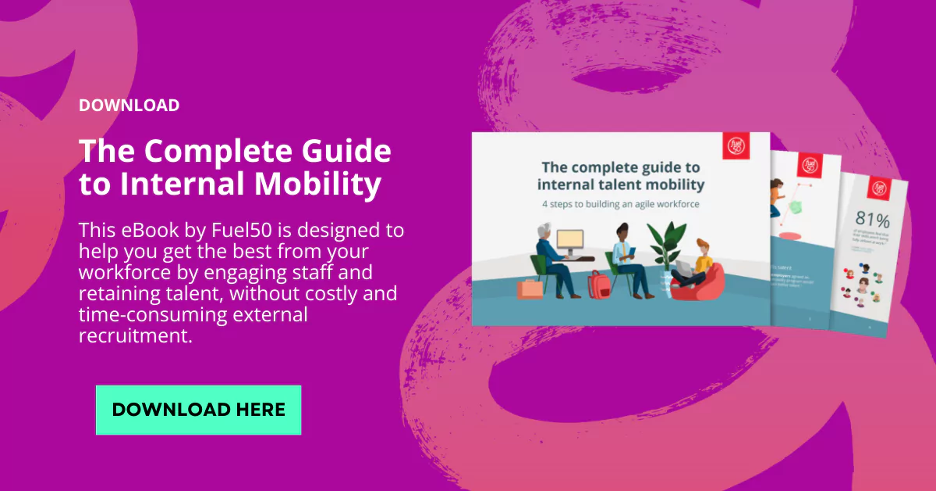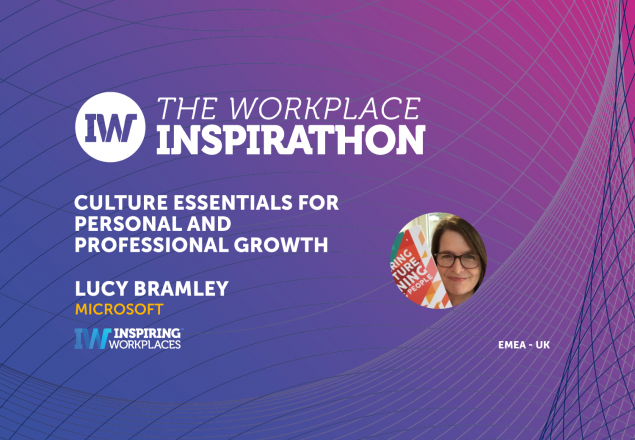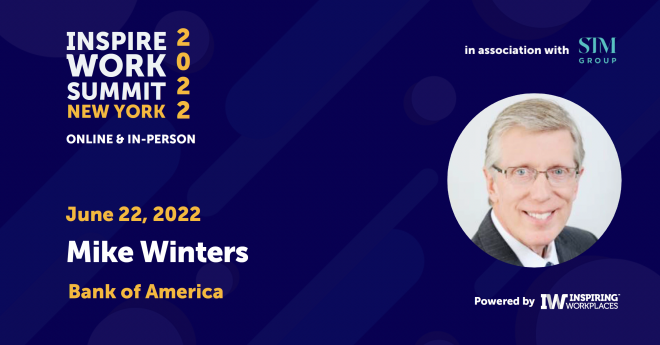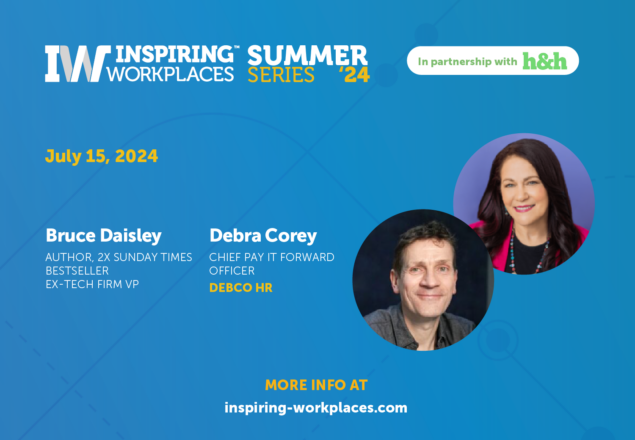
21st May 2025
Guest Post: Beyond Career Ladders – The Rise of Career Ecosystems

This article was written by Roel Deuss, VP of Solutions at Fuel50.
Research shows nearly half of employees who quit cite “no opportunities to advance” as their primary reason.
But the issue isn’t a lack of opportunity—it’s that most organizations are still offering career ladders in a world that now demands ecosystems.
Career ladders were built for stability. They assumed long tenures, fixed roles, and a slow pace of skill change. That model made sense when skills lasted 10–15 years and careers moved in linear steps. But today, the average skill half-life is under five years. Talent moves faster, learns differently, and expects more dynamic pathways.
Career ecosystems are built for this new reality. They reflect how people actually grow: laterally, experimentally, and across functions—not just up. They prioritize capability development over title progression, and give employees multiple ways to add value, not just a single “next step.”
They also demand a new mindset from organizations: one where the question isn’t, “Who’s next in line?” but “Where can this person grow next—and how do we help them get there?”
In this article, we’ll break down what a career ecosystem looks like, why it matters now more than ever, and how to start building one in your organization.
Why traditional career paths are breaking down
In most organizations, upward mobility is structurally limited. Even in a seven-level hierarchy, the majority of employees will reach a ceiling long before leadership roles open up. Performance alone doesn’t guarantee progression—there simply aren’t enough spots.
This model was built for a slower pace of change. It assumed long skill life cycles and stable role definitions. That’s no longer the case. The half-life of technical skills is now under five years, while promotion cycles remain spaced out over three to five years. Timelines don’t match. Employees outgrow roles faster than organizations update them.
As a result, roles feel static, and career movement stalls. Only 36% of employees believe their current role uses their strengths. More than half of high-retention-risk employees cite lack of development—not compensation—as the main reason they’re considering leaving.
The frustration is widespread. Seventy-six percent of employees say they feel stuck in their current role, according to LinkedIn’s 2023 Workplace Learning Report. Growth often requires switching employers, not switching roles.
The traditional ladder no longer reflects how people build skills or navigate careers. And without an alternative structure, companies risk losing talent they already have the capacity to develop.
The makeup of a career ecosystem
A career ecosystem replaces rigid advancement tracks with an interconnected network of opportunities based on skills, not titles. Unlike ladders that funnel talent upward through predetermined stages, ecosystems enable multidirectional movement—sideways, diagonal, or circular—following skills demand rather than hierarchical convention. They transform development from a series of promotions into a continuous exchange of capabilities between individuals and the organization.
The University of California, Irvine (UCI) provides a compelling case study of this transformation in action. Despite being ranked among the nation’s top public universities with over 11,000 staff, UCI faced the same retention challenges as most organizations: Employees wanted growth opportunities but couldn’t find clear pathways within the institution. Their engagement surveys revealed that skillful personnel enjoyed working at UCI but were prepared to leave to advance their careers.
Instead of doubling down on traditional advancement tracks, UCI reimagined their entire talent infrastructure. They implemented a talent marketplace that mapped skills across the organization and created multiple pathways for growth beyond vertical promotion. As a result, UCI reduced their attrition by 50% and now maintains a 4% turnover rate in an industry where 13%-15% is the norm.
What makes this ecosystem approach distinct is its focus on skill mobility rather than role advancement. When UCI’s Chief Information Officer Kian Colestock said, “We have many silent skills within our org chart that we’re not using because that’s not what that person was hired for,” he identified the fundamental limitation of traditional structures.
By using intelligence-driven matching of profiles and skills, UCI uncovered capabilities that were invisible in their hierarchical framework.
This shift from “next job up” to “next skill across” manifested in practical innovations like UCI’s “gigs” program—short-term projects that allow employees to work in different departments. The program was so successful that it sparked “reverse gigs,” where employees specify what opportunities they want to explore, and leadership works to create them.
The power of lateral moves becomes evident in how they accelerate career growth. A traditional promotion might offer incremental responsibility in a familiar domain, but lateral moves build versatility and adaptability, which are the qualities organizations need most in rapidly evolving environments. At UCI, 15% of platform users have now identified target roles that previously weren’t on their radar, thus expanding their career horizons beyond the limitations of departmental silos.
While standard career ladders might add depth to an employee’s existing expertise, ecosystem moves give breadth that often yields more valuable skill combinations. Consider an employee who moves from marketing to product development, bringing customer insights that transform product strategy, or a financial analyst who rotates through operations, developing a unique perspective on process optimization. These diagonal moves create skill intersections where the most valuable innovation often occurs.
The ecosystem model doesn’t eliminate upward mobility but, rather, contextualizes it within a broader network of growth opportunities. What emerges is a talent infrastructure that adapts to both organizational needs and individual aspirations, connecting people to possibility rather than predetermining their path.
Build your organization’s career web
Transitioning from rigid career ladders to dynamic ecosystems requires systematic reconstruction, not incremental improvement. Organizations that successfully build career webs follow four essential steps, each of which dismantle a specific barrier to talent mobility:
- First, break down informational silos that keep opportunities hidden. Traditional organizations operate as talent islands, with hiring managers unaware of capabilities in adjacent departments. Begin by conducting a comprehensive skills inventory that transcends job descriptions. Focus on capabilities, not credentials.
- Next, develop a unified skills taxonomy that enables cross-departmental translation. Most organizations use inconsistent language to describe similar capabilities; for instance, what marketing calls “audience analytics,” finance might call “statistical modeling.” This language fragmentation prevents talent flow.
- Then, open structural visibility into opportunities that exist beyond traditional advancement paths. Employees can’t pursue what they can’t see. So, establish an internal opportunity marketplace that functions like a neural network, connecting skills to projects, stretch assignments, and cross-functional roles.
- Lastly, institutionalize short-term projects as legitimate development vehicles. Traditional career progression requires full-time role changes, but skill building happens most effectively through varied experiences.
The organizations that execute these four steps share a common trait: They measure success differently. Rather than tracking promotion rates, they monitor skill acquisition velocity, internal placement percentages, and talent retention correlations.
With 40% of core skill requirements expected to change by 2025 according to the World Economic Forum, organizations that cling to rigid advancement structures will face talent shortages and employee disengagement simultaneously. Career ecosystems solve both problems by connecting existing capabilities to emerging needs.
A particularly enticing aspect of this approach is that it doesn’t require additional head count or massive investment, just a reimagining of how people work in your organization. The talent you need likely already exists within your walls; a career web simply allows it to move where it creates the most value.
How talent intelligence transform career navigation
Career ecosystems require sophisticated navigation systems so employees don’t become lost and organizations avoid missing critical talent connections. Talent intelligence platforms like Fuel50 fill this role by transforming how people discover opportunities and how organizations understand their talent.
The breakthrough comes from Fuel50’s expert-driven skills ontology—a framework meticulously structured by I/O psychologists that maps thousands of skills, capabilities, and competencies with their interconnections.
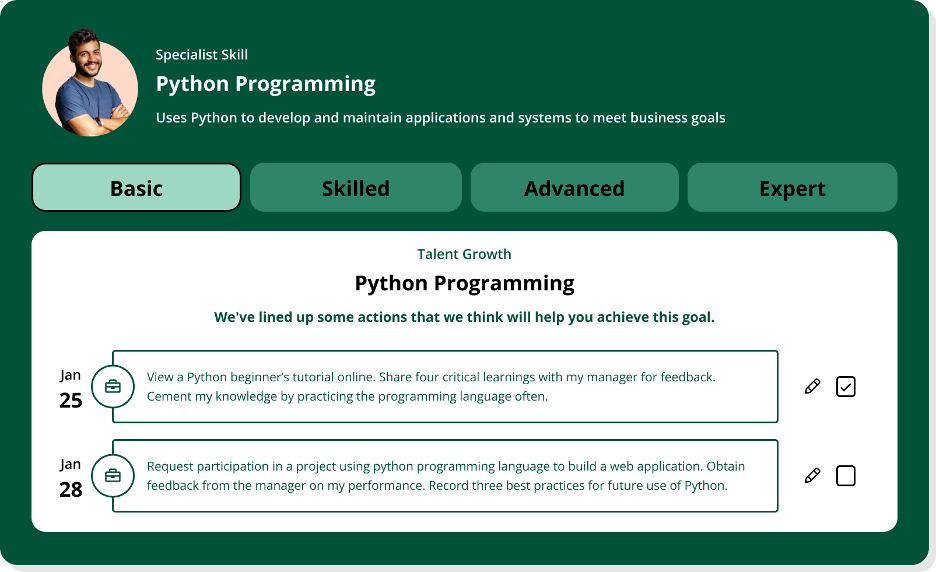
Unlike basic keyword matching that might see terms like “project coordination” and “program management” as unrelated, Fuel50’s ontology understands their relationship and creates bridges between skills that traditional systems treat as isolated islands.
This intelligence unlocks career transitions that would otherwise remain hidden. At KeyBank, the implementation of skills-based matching assessed 9,858 skills across their workforce and identified 2,774 specific upskilling opportunities.

That precision revealed that many employees were much closer to high-demand roles than their job titles suggested, they simply needed targeted development in specific capabilities. The platform’s regular 72% user return rate demonstrates how compelling these newly visible pathways become when employees discover them.
The democratization of opportunity happens through hyper-personalization: Fuel50 constructs what we call a “career DNA” for each employee that captures not only skills but also aspirations, values, and potential.
These multidimensional profiles enable the platform to suggest developmental pathways tailored to individual growth patterns rather than generic career tracks.
The power of this approach lies in how it simultaneously addresses organizational talent gaps and fulfills individual growth needs. So, employees find growth opportunities they couldn’t see before, and organizations discover capabilities they didn’t know they had.
The impact extends beyond individual transitions, though, to organizational intelligence. Fuel50’s Talent Blueprint feature automatically maps skills to roles, producing a dynamic skills architecture that evolves with the business.

This gives leadership greater visibility into capability distributions, adjacent skill, and developmental patterns across the enterprise. With multiple different reports tracking everything from skill gaps to mobility patterns, companies gain the data necessary to make strategic workforce decisions, rather than relying on intuition or surface-level metrics.
Perhaps most importantly, this intelligence layer ensures equity in opportunity distribution. Traditional advancement often favors those with strong internal networks. However, Fuel50’s ethical AI incorporates multiple bias checks in its algorithms, and all content undergoes thorough reviews to eliminate stereotyping. This structured approach to opportunity matching ensures talent isn’t overlooked because it sits in unexpected places within the organization.
The resulting ecosystem transforms career navigation from a series of predetermined steps to a personalized journey: Individuals can follow their unique pathway while remaining aligned with organizational needs. It’s not just a better career ladder—it’s an entirely different methodology for how talent and opportunity connect.


